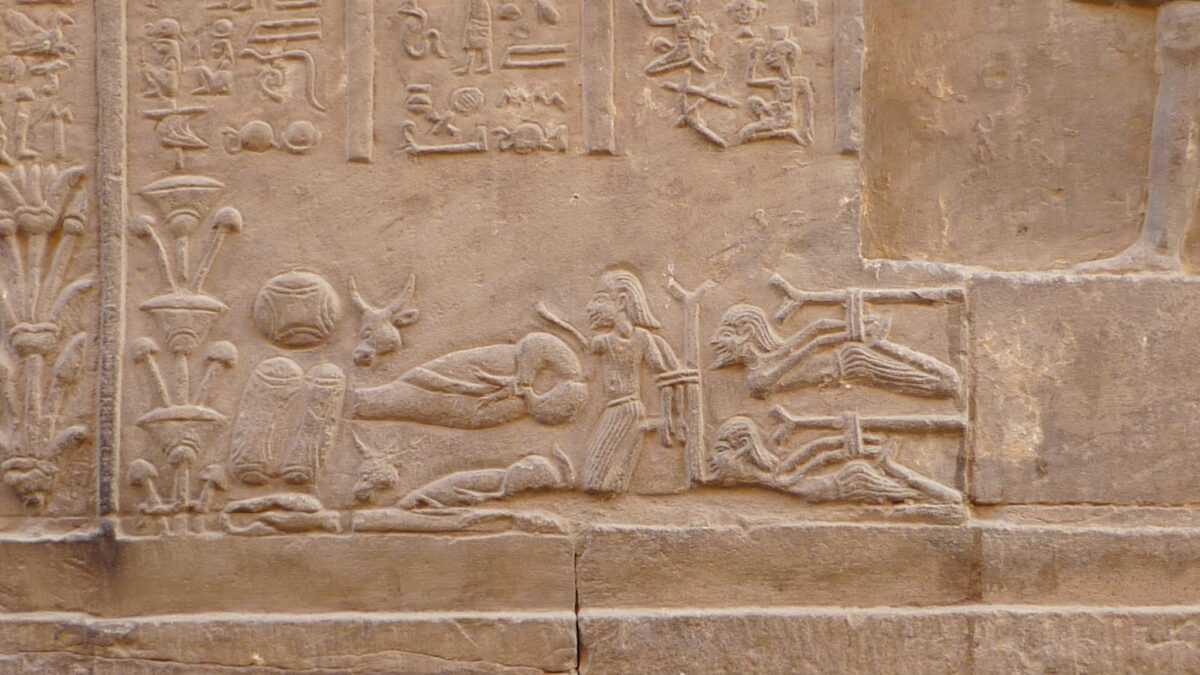
Crucifixion in Ancient Egypt: An Analysis of the Kom Ombo Relief
Introduction
Crucifixion is most famously associated with the Roman Empire, where it was perfected as a method of public execution. However, visual and archaeological evidence suggests that forms of public bound suspension as punishment predate Roman practices. One striking example appears in a relief from the Temple of Kom Ombo in ancient Egypt. This article examines whether such depictions constitute an early or “proto” form of crucifixion.
The Kom Ombo Relief: A Closer Look

In the Kom Ombo wall relief, several captives are shown bound to poles in two distinct positions:
- Vertical Figures: Individuals tied upright to wooden stakes, likely prisoners or enemies.
- Horizontal Figures: Two individuals bound flat to a pole, stacked and fully suspended off the ground.
These are not symbolic illustrations. They represent real methods of physical restraint and public display—both critical aspects of execution or punitive rituals in ancient states.
Key Features Matching Crucifixion
| Feature | Kom Ombo Relief | Roman Crucifixion |
|---|---|---|
| Suspension off ground | Yes (horizontal and vertical forms) | Yes |
| Binding with rope | Yes | Yes (especially early executions) |
| Public humiliation | Yes | Yes |
| Display for deterrence | Yes | Yes |
| Position causes suffering | Likely (asphyxiation, dehydration) | Yes |
| Execution method | Possibly | Definitely |
Functional Parallels
The horizontal binding seen in Kom Ombo may appear distinct from the Roman upright cross, but both practices involve:
- Suspension to prevent rest or movement
- Respiratory restriction due to body positioning
- Tying limbs to fixed points to immobilize the victim
In both systems, death could result from exposure, asphyxiation, or follow-up execution. Thus, while the form differs, the function is nearly identical.
Evolution of Execution Practices
- Egyptian Binding: Likely used for public punishment, ritual humiliation, and execution. Often tied to state authority or religious control.
- Roman Crucifixion: Systematized into legal penalty for slaves, rebels, and enemies of the state. Often involved nailing, but tying was also common.
Both systems aimed to:
- Display dominance
- Deterrence through visible suffering
- Strip dignity from the condemned
Qur’anic and Anatomical Context
Given the striking similarities in method and purpose, the Kom Ombo relief can be interpreted as an early precursor to crucifixion—what might be called proto-crucifixion or pre-Roman crucifixion. While not identical in technique, it embodies the core elements: public suspension, immobilization, suffering, and spectacle.
The Qur’an also references crucifixion as a form of punishment in several verses (e.g., Surah Al-A’raf 7:124, Surah Taha 20:71), including during the time of Pharaoh, saying: “I will surely crucify you on the trunks of palm trees and you will surely know which of us is more severe in [giving] punishment and more enduring.“ (Qur’an 20:71). While the term used “uusalibannakum” may include impaling and and other forms of suspension, it does not preclude an alternate form of crucifixion by suspension. In fact, scenes such as the Kom Ombo relief provide visual and historical grounding for a broader understanding of what the Qur’an may have referred to—forms of crucifixion or execution by suspension already in use in ancient Egypt.

A close anatomical reading of the Kom Ombo figures supports this. The horizontal captives’ heads are depicted tilted backward, jaws unnaturally forward, which is a strong indicator of suspension and gravitational strain. Additionally, the positioning of the deltoid muscles and shoulder joints shows torsion and downward pull, indicating the body is hanging rather than lying flat. Further, there is evidence of hanging allowance in the binding technique: the horizontal figures appear to be loosely tied, offering slack for full body suspension, unlike the vertical figures, who are fast-bound with structural support. This contrast highlights a deliberate design for total suspension in the horizontal layout, rather than simply tying for containment.
Compared to the vertical figures, whose posture appears more structurally supported, the horizontal captives clearly demonstrate a suspended, exsanguinated, and immobilized state — consistent with methods of execution through crucifixion by tying.
One of the earliest documented references to crucifixion-like punishment in ancient Egypt comes from the Rosetta Stone, dated to 196 BCE, during the reign of Ptolemy V Epiphanes. Written in three scripts — Greek, Demotic, and hieroglyphic — the decree celebrates the king’s victories and reaffirms religious privileges. In the Greek portion, it describes how those who defied the king’s authority and desecrated temples would face severe punishment, stating that such offenders would be “impaled” (Greek: ἀνασκολοπίζω), a word often translated as “fixed to a stake.” While traditionally interpreted as impalement, scholars note that this term could just as likely refer to suspension on a stake or pole, matching what is later defined more precisely as crucifixion. This phrasing, appearing over a century before the height of Roman crucifixion, demonstrates that public suspension punishments were already codified into Ptolemaic legal doctrine — reinforcing the idea that Egyptian practice may have included, or directly influenced, early forms of crucifixion.
It becomes clear that, crucifixion did necessarily begin with Rome. It evolved independently in other cultures, including those clearly depicted in the art and punishment rituals of ancient Egypt — and likely referenced in early scriptural traditions, including the Qur’an.


